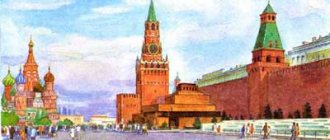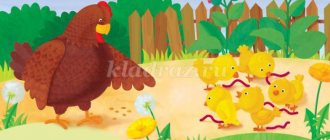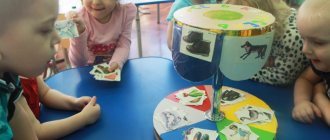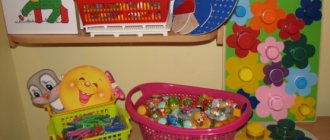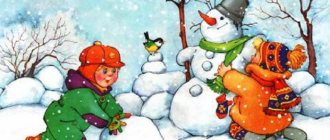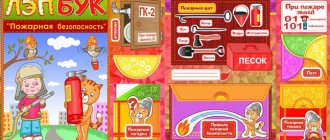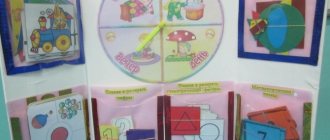"Circles of Llull" are a set of interconnected circles or rings in the shape of a pyramid. The creator of this complex of developments is the French monk Raymond Llull. The history of the game's creation began with work on the development of speech functions and logical thinking.
Currently, “Pacification Circles” are actively used by teachers and speech therapists in kindergartens. Thanks to its simple design and wide functionality, this product is understandable and easy to use, and is indispensable in the work of teachers.
How to use Lull circles?
Circles of Llull - what are they? This is a kind of pyramid with pictures, words or numbers. The arrow is located above the circles. All rings are movable and can be rotated in both directions. The rings are divided into several sectors. As the circles rotate, the arrow highlights certain sectors at each level. Sectors can contain pictures, riddles and entire sentences.
The player asks a question and spins the toy. The resulting combination can be interpreted as an answer to the question, and imagination and logic are associated with decoding.
Modern “circles” are divided by topic. Together with your children you can study “Fruits and Vegetables”, “Animals”, “Clothing” and so on. “Circles of Calm” are ideal for introducing a child to the outside world. In a playful way, preschoolers learn new words, their meanings and functions.
“Quiet Circles” are especially recommended for the following activities in a preschool educational institution:
- Familiarization with surrounding objects;
- Development of coherent speech;
- Knowledge of mathematics;
- Development of thought;
- Ability to establish logical connections between objects;
- Comfortable socialization and communication with people, etc.
You can create “Lulle circles” with your own hands. The topic is selected at the discretion of the teacher for a particular lesson.
Private educational institution modern modular center "Development"
Volkova Natalya Borisovna teacher-psychologist, 1st qualification category
Zolina Venera Egorovna teacher of Tatar language teaching, 1st qualification category
MBDOU "Kindergarten No. 120 combined type" Sovetsky district of Kazan
Currently, the Federal State Educational Standard for Preschool Education and the Professional Standard for Educators establish norms and regulations that are mandatory in the implementation of the basic general education program of preschool education - to ensure that students achieve school readiness. One of the indicators of a child’s readiness for school is the formation and development of logical thinking. One of the most complex mental operations is classification. To achieve an optimal level of development of this mental operation, it is very important to use means of optimizing the learning process that will enable the child to visually represent concepts. Therefore, one of the main tasks is to master the action of visual modeling, since it is visual models that are most suitable for classes with preschoolers, since they are inherent in children's activities.
In modern conditions, a child is required not only to possess knowledge, but also to be able to obtain this knowledge himself and operate with it.
One of the main tasks of modern pedagogy is the search for opportunities to use the hidden reserves of children’s mental activity, the search for ways of effective learning. And in the field of education, the learning process must inevitably be more visual and dynamic. One of these ways that intensively develops children's cognition can be modeling.
Modeling techniques are especially effective for preschoolers, since they have developed visual and effective thinking, memory is involuntary, and mental tasks are solved with the predominant role of external means; visual material is absorbed better than verbal. The visual modeling method helps the child visualize abstract concepts and learn to work with them.
In work, visual modeling helps prevent rapid fatigue, create interest in classes, teach children to see the main thing, and systematize the knowledge gained.
Children very easily and quickly understand various kinds of schematic images and use them successfully.
One practical and convenient model for solving logical problems is proposed by the outstanding scientist Leonhard Euler.
Euler circles are a graphical model that can be used to visualize relationships between concepts or sets of objects. And popular wisdom says: “It is better to see once than to hear a hundred times.” Considering the simplicity and clarity of the Euler circle model, it is successfully used in kindergartens.
Our game “Magic Circles” is a diagram that allows you to visualize the relationships between subsets and the intersection and union of sets. When solving some problems, Euler's method is simply irreplaceable and greatly simplifies reasoning.
Using “Magic Circles”, the child masters the following elements of logical actions:
— analysis of objects in order to identify features;
- synthesis - composing a whole from parts;
— selection of criteria for comparison and classification of objects;
— establishing cause-and-effect relationships;
— building a logical chain of reasoning.
The method of visual modeling using our game is most often used for the cognitive development of preschoolers. Starting from 4-5 years old, children can solve simple problems, first with explanations from adults, and then independently. With children of this age, simple games and exercises are appropriate, the purpose of which is to consolidate ideas about the properties of objects and geometric shapes, training in comparing objects by color, shape, size.
The relevance of the development of the didactic game “Magic Circles” is determined by the focus on implementing the developmental function of education, which is a key task of the modern educational situation in general and in preschool education in particular.
The didactic game is designed to:
- development of cognitive processes and mental abilities,
- learning and consolidation of the native language,
- development of memory, attention, logical thinking,
- development of emotional intelligence.
The content of methodological recommendations includes:
— description of the game.
— stages of mastering the action of visual modeling.
— methodological recommendations for organizing children’s activities.
The practical significance of the proposed didactic game is associated with the inclusion in the content of specific examples of work using the visual modeling method.
Forms of working with the game – subgroup and individual.
To begin with, the teacher explains to the children the spatial concepts of “inside the circle” and “outside the circle.” It is important to teach your child to use the particle NOT to indicate the attribute of objects outside the circle.
The teacher places the hoop on the table, shows the place that is inside the hoop and tells that the rest of the table is outside the hoop.
The goal of working with one circle is to teach how to classify objects according to one criterion, understand and apply the logical operation of negation NOT, without naming it.
Each child has one object in his hand. Children take turns placing objects in accordance with the teacher’s instructions. Place all the toys inside the hoop, and all other objects outside the hoop. Then a conversation is held on the following questions:
- What objects are inside the hoop? (toys)
- What objects were outside the hoop?
The important thing is that there are toys inside the hoop, and there are no other objects there.
Then we proceed to distribute the items into two circles. We explain the concepts of “inside the circle” and “outside the circle” using two signs.
Children complete these simple tasks:
— Place toys inside the red circle.
— Place the cubes inside the blue circle.
After all the figures are placed, the teacher asks two new questions:
— What objects lie inside the red circle? (There are toys inside the circle).
— What objects are inside the blue circle? (There are cubes inside the circle).
— What objects lie outside the circle? (Outside the circle are NOT toys, NOT cubes).
You can use several circle models with preschoolers:
- disjoint circles;
- intersecting circles;
- one circle is nested within another.
The goal of working on problems with two circles is to develop the ability to classify objects according to two properties, understand and apply the logical operation of conjunction.
Children will now work with two circles or hoops of different colors (blue, red) with overlapping areas.
After successfully completing the preparatory exercises, you can begin solving problems.
The method of visual modeling using games can also be used in the speech development of preschool children. Figurative speech, rich in synonyms, additions and descriptions, in preschool children is a very rare phenomenon. There are many problems in children's speech.
Therefore, pedagogical influence on the development of speech in preschoolers is a very difficult matter. It is necessary to teach children to express their thoughts coherently, consistently, and grammatically correctly, and to talk about various events from the surrounding life.
Preschoolers with various speech disorders experience significant difficulties in mastering both the preschool education program and subsequently the general education school curriculum. When working with children, the teacher has to look for auxiliary means that facilitate, systematize and guide the process of children learning new material.
Such tools are graphical models using Euler circles.
The elements of a descriptive story are the qualitative characteristics of the object:
- belonging to a generic concept, size, color, shape, constituent parts, surface quality, material from which the object is made (for inanimate objects), how it is used (what benefits it brings).
First, the child draws up a model for describing objects according to plan. In this case, description symbols (pictograms) are laid out in hoops.
Then, at the intersection of circles, identical features of objects are highlighted. Now you can compose a descriptive story according to this scheme, first identifying the similarities and then the differences of objects.
The method of visual modeling using our game can be used to familiarize preschoolers with the world around them.
Children are offered a set of cards to solve problems. For example:
- Arrange the cards so that everything edible is in one circle, and fruit is in the other (one circle is nested inside the other). Children identify objects that match the descriptions of the circles. It is important to draw the child’s attention to those qualities that are always inherent in the object.
- Arrange the cards so that one circle contains fruits and the other contains vegetables (non-overlapping circles). Children identify objects that match the descriptions of the circles.
- Arrange the cards so that in one circle there are all the fruits, and in the other - all the red objects (intersecting circles, at the intersection - a card with an apple). First, children identify an object that matches the description of the circles. Each of the intersecting circles is assigned a quality. Then you need to find an object that fits the description of those circles that have a common intersection.
During the next lessons, children can be offered more complex tasks, when the intersection of two circles may contain not one, but several cards.
Another aspect of the use of this game can be illuminated in the development of the emotional intelligence of a preschooler in the work of a preschool educational psychologist .
First, we introduce children to basic emotions: sadness, joy. We invite children to put all the pictograms that evoke positive emotions in one circle, and negative ones in the other. We ask questions to help analyze situations:
- Do you think all events located in the first circle can be classified as joyful?
- What events are considered sad and sad?
Then we connect the circles and place an emotion card at the intersection of the two circles and select pictograms that correspond and are opposite to this emotion.
Over time, the set of studied emotions expands and the set of pictograms corresponding to them also expands.
This game can also be used as diagnostic projection material for intra-family relationships, fears, anxiety and leadership aptitudes.
Also, the game “Magic Circles” is used by a native language teacher to reinforce material on certain topics.
For example, at the intersection of the circles we put a drawing of a hare, and in the circles the children put pictograms indicating the characteristics characteristic of this animal (color, action).
In the study of vegetables and fruits, three circles are used, in which some children put signs (color, taste, size), and others must determine which vegetable or fruit they are talking about.
So, in this methodological development, the main actions that can be performed with sets were considered, the possibilities of their use for solving problems were studied, and methodological advice was given on organizing children's educational activities using the game “Magic Circles”.
Using this game in working with children, we contribute to their development of the skills to analyze objects in order to isolate features, carry out analysis and synthesis, that is, to compose a whole from parts, including independently completing sets with missing components, the skills to compare and classify, generalize, make conclusions and conclusions, build logical chains, reason.
The material can be used as handouts for a group of children, or in individual work with preschoolers by preschool teachers, and can be recommended to parents.
LITERATURE
- Poddyakov A. Development of combined abilities.// Preschool education. - 2001, No. Yu.-S.90-96
- Korneeva G. Modern approaches to teaching preschoolers mathematics. // Preschool education. - 2001, No. 3. - P.46-49.
- Nemov R.S. General psychology: A textbook for students of educational institutions of secondary vocational education. - M.: Humanitarian Publishing Center VLADOS, 2001. - 400 p.
- Stepanova O.A. Game school of thinking.-M.: Education, 2003.
- Tikhomirova L.F. Exercises for every day: logic for younger schoolchildren. - Yaroslavl: Academy of Development, 2001.
TRIZ technologies in kindergarten Circles of Lullia.
TRIZ technologies in kindergarten Circles of Lull.
One of the effective pedagogical technologies for developing children's creative abilities is TRIZ - Theory of Inventive Problem Solving.
The purpose of using TRIZ in kindergarten is to develop, on the one hand, such mental qualities as flexibility, mobility, coherence, and on the other hand, research, the desire for novelty, language development and creative imagination.
I bring to your attention a game system of tasks and exercises based on the invention of Raymond Llull - “Circles of Calm”. Which is directly related to TRIZ technology. The invention received its name in honor of the name of its creator. In the 13th century, a French monk created a logic machine in the form of paper circles.
In my work, I use Llull circles as a play technique aimed at enriching a child’s vocabulary, developing cognitive activity, and expanding ideas about objects. They are effectively used in pedagogy to develop the linguistic, intellectual and creative abilities of children.
Lull circles are presented to preschoolers in the form of wonderful rings or mysterious circles. To work with children 3-4 years old, it is recommended to take only two circles of different diameters, 4 sectors in each.
When working with children 5-6 years old, two or three circles are used (4-6 sectors in each).
What else to read: Master class “Multifunctional educational panel for preschool children”
Children of the 7th year of life cope with a sufficient number of tasks that use four circles of 8 sectors each.
It is recommended to play games outside of class in the form of play exercises (individually or with subgroups of children). Pictures on a specific topic are attached to the sectors.
The game should consist of two parts:
1) clarification of existing knowledge in certain areas (real task);
2) exercises to develop imagination (fantastic task).
Technological chain of the game:
1. In all areas of the circle, images or signs indicate any objects.
2. The activity is configured.
3. The circles are spinning, the children look at what images are on the circles under the arrow and name them.
4. Create a story based on the fantastic transformation.
The discs are suitable for all ages. For my older children I use games like “From what?”, “Professions”, “More or less”.
But the game is also suitable for young and middle-aged people. I have prepared games such as “Whose Tail?”, “Opposites”
, “Whose shadow is this?”, “Take a pair.”
Games with “Circles of Calm” can be divided into three types:
1. Matching games:
“Name the puppy.”
2. You play with an element of randomness in the placement of rings:
D / I “Zoom out, increase” D / I
3. Games to develop creative imagination:
D/I “Whose puppy?” D/E “seasons”
You can create this guide yourself. I bring to your attention step-by-step instructions.
For manufacturing you will need: a sheet of plywood 4 mm thick, chipboard spacers (for support), a threaded rod, washers, nuts.
Draw three circles with a diameter of 40, 20 and 10 cm and cut out the circles with a jigsaw.
Drill a hole in the center of each circle. I spray painted it. We divide the structure we have made into 8 parts - sectors. We attach a piece of linden to each part, after which there is a long and painstaking process of selecting images on which the linden is also attached.
The kids participated in cutting and pasting pictures for small Lilluj clubs.”
Therefore, Llull circles can be used in any area: to consolidate knowledge of numbers and the ability to count objects (on one ring there is a group of objects, on the other there is a corresponding number), knowledge of geometric figures (connect an object of a certain shape with a standard, for the development of phonemic hearing (link an image with a letter) , indicating the first sound in a word, and on the third ring you can depict a syllabic analysis scheme and count the syllables in words).
The uses for this technique are endless. Our teachers are actively studying it, the children really like it, and we also recommend it for you in your work.
Thank you for your attention.
Children's master class on manual labor “Didactic game “Magic Circle. Guess the fairy tale""
Morozova Marina Yurievna
Children's master class on manual labor “Didactic game “Magic Circle. Guess the fairy tale""
Materials for the master class : colored cardboard, a set of colored paper, scissors, glue stick, printouts depicting fairy-tale characters .
The master class was performed by the guys from the whole group in pairs.
At the preparatory stage of the master class, the guys cut out fairy-tale characters .
Nastya and Rodion carefully cut out the characters from the fairy tale .
Makar and Yegor carefully completed part of their work.
Martin and Zakhar took their task responsibly.
At the next stage, master class Makar and Rodion very carefully cut out two parts along the contour - round .
Rodion cut out a circle , divided into equal sectors. This is the base of " Magic Circle "
.
Makar carved a colorful rotating circle that overlaps the circle with sectors .
Examples of games with “Lulli circles”
"Animals and Cubs"
Animals are depicted on the upper ring, and their young are depicted on the large one. The teacher names any animal. By turning the circles, the child must find a child named animal. For example, a kitten is paired with a cat, and a puppy is paired with a dog. The player’s task is to find each child his mother and vice versa.
"Fairy Tales and Heroes"
The rings depict heroes of famous fairy tales and objects belonging to them. The teacher names the hero, and the child looks for what the character uses in the story. For example, Baba Yaga is a stupa or a broom, Pinocchio is a key, etc. The children's task is to find their own thing for each hero.
What else to read: Making toys with your own hands: step-by-step instructions and visual examples
"Count"
The rings represent objects and numbers. How to play? The teacher rotates the arrow and names the released image. The child’s task is to count how many objects are in the picture and name the correct number. For example, two balls, four books, etc.
"Sochetayka"
The rings depict random objects: trees, colors, words. The teacher spins the arrow. The children’s task is to tell how to connect the fallen images. For example, you will get a pair of wooden ones - red. This means that the leaves change and turn red in the fall. Do the same with the following combinations.
Lull's Circles is a simple educational game that has a positive effect on children's brain activity. In a playful way, the baby not only stimulates thinking, but also spends pleasant and funny moments with friends.
Educational didactic game “Magic Circle”
Alena Chumak
Educational didactic game “Magic Circle”
Presentation of the author's educational game
Author's full name: Chumak Alena Sergeevna
Name of preschool educational institution: “D/S “Nastenka”
Game name: " Magic Circle "
Children age group: 2-3 years
Goals: creating a social situation for the development of children in the process of cognitive and play activities “ Magic Circle ”
;
children's sensory abilities (ideas about color, shape, size)
.
1. create conditions for the formation of an idea about the game “ Magic Circle ”
;
2. create conditions for the development of thinking , auditory attention and active speech of children;
3. create conditions for familiarization with wild and domestic animals and their food;
4. create conditions for familiarization with different geometric shapes and colors;
5. create conditions for enriching and accumulating children’s sensory experience during object-based play activities through games with didactic material .
